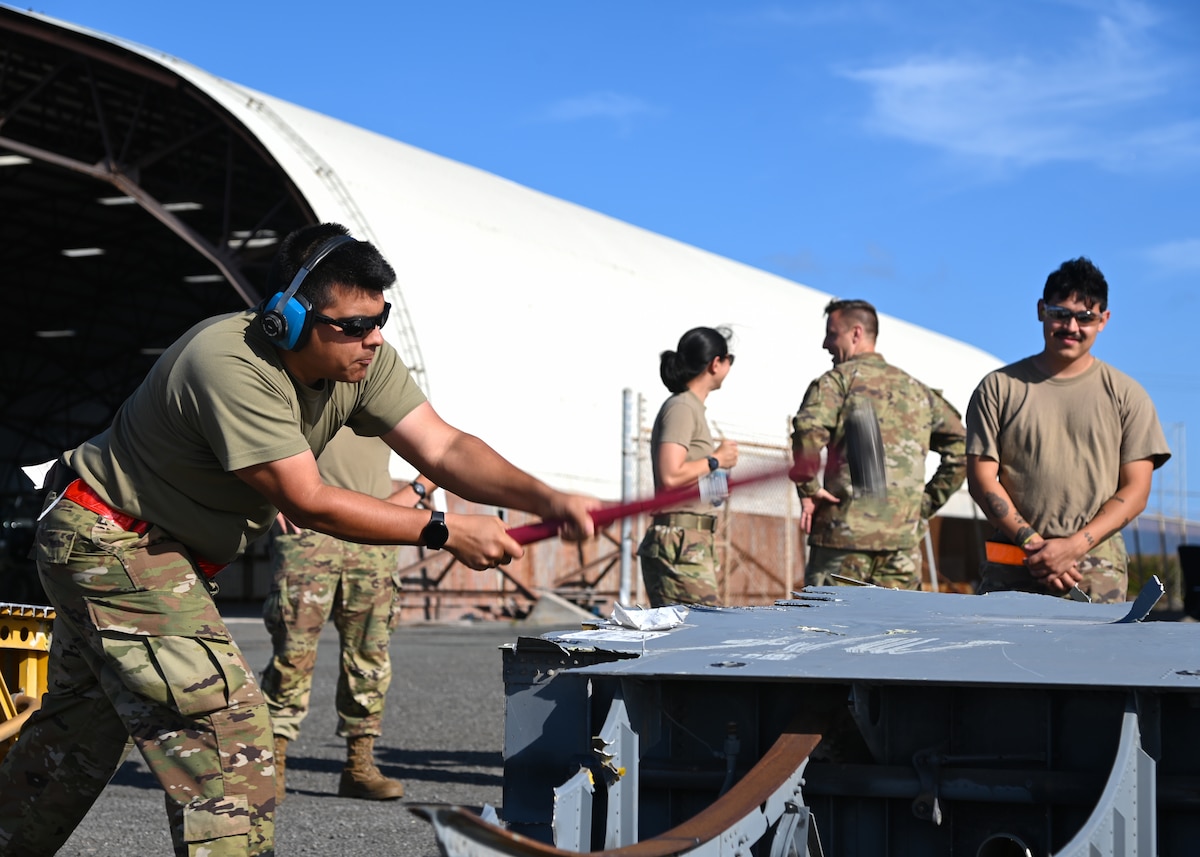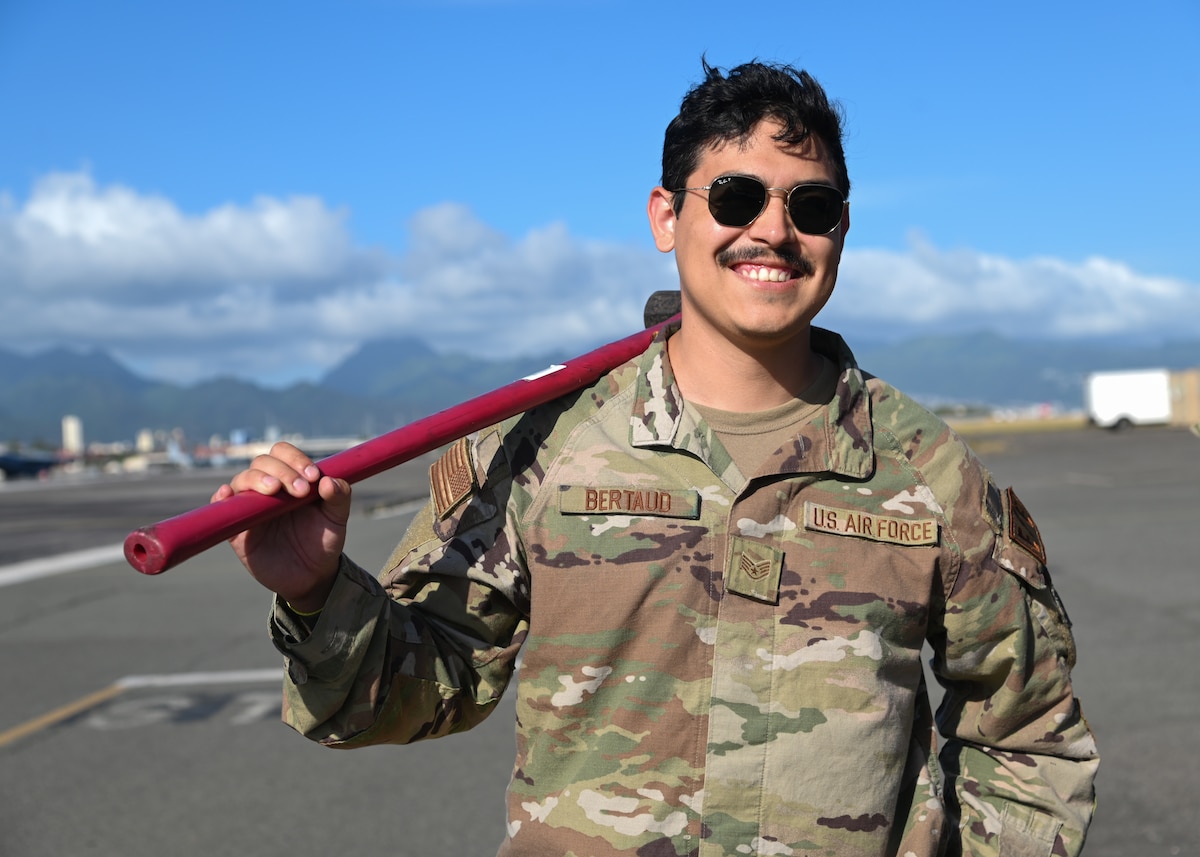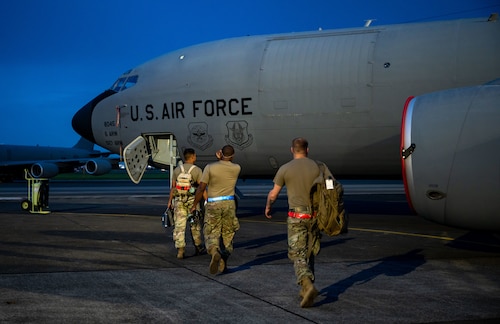Wartime contingency and campaign planners can learn a lot from a major multi-national exercise, with dozens of aircraft carrying thousands of participants and moving tons of materiel and equipment across the Indo-Pacific theater.
Air Force Materiel Command logisticians have worked behind the scenes on exercise Mobility Guardian 23 since Fall 2022 and are critical to the successful planning and execution of Air Mobility Command's largest, and arguably most challenging, exercise in years.
"This exercise is really highlighting how the AFMC logistics enterprise supports the warfighter," said Col. John Klohr, Headquarters AFMC logistics lead. "The vast distances and water make pre-positioned War Reserve Materiel critical to our readiness in the Indo-Pacific theater."
The exercise runs July 5-21, 2023. It is a major test of emerging operational concepts including the Air Force's Force Generation Model and Agile Combat Employment, which features a hub-and-spoke base network of several operating locations manned by multi-capable Airmen to generate combat sorties.
Gen. Mike Minihan, AMC commander, visited Wright-Patterson AFB last fall for a senior staff-to-staff engagement to highlight his readiness objectives and ask for AFMC's help.
"That really kind of kicked off all the support for this specific exercise," said Rich Moore, a senior analyst at the Air Force Sustainment Center assigned to Wright-Patterson AFB. "That's kind of telling, I think, when the operators come here saying, 'we need you.'"
Logistics on the Attack
In March 2023, Minihan shared the stage with Gen. Duke Z. Richardson, AFMC Commander, during the annual Air Warfare Symposium hosted by the Air and Space Forces Association. They jointly highlighted the logistics challenges posed by the tyranny of distance and ocean in the U.S. INDOPACOM area of responsibility and the urgency to get ready, in an integrated way, to deter, fight and win there. The discussion highlighted the need to rapidly deploy, operate and sustain a high-tempo fight, which will require Airmen to think differently. The generals emphasized during their joint panel that pre-positioned war reserve materiel supports a "distributed laydown" and interoperability with allies and partners.
This theme was also telegraphed by Air Force Chief of Staff Gen. CQ Brown, Jr., during his recent confirmation hearing to serve as the next chairman of the Joint Chiefs of Staff.
You cannot wait until the crisis occurs to be able to deploy capability," Brown told committee members. "You have to work with allies and partners to have access to locations so you can put that capability in place."
Fast forward to Mobility Guardian and the logistics planning and agile combat employment, theory is being put to its largest test yet.
"If you just trace the supply chain of what it takes to fight a war, all of it runs through AFMC," Moore said.
Requirements for spare parts, support equipment, fuels, munitions planning and more need to be forecasted and aligned with the war plan, he said, adding Mobility Guardian is part of a series of logistics-focused wargames the command is using to refine processes.
AFMC centers deliver range of support
The Air Force Sustainment Center "depot surge" is just one area where AFMC civilian and uniformed Airmen supported the exercise.
"We asked, 'What parts can we surge?' and 'How can we get tankers out of depot sooner?' We then looked at some of the authorities and things within our control to accelerate our processes," Klohr said. "So the planning aspect of Mobility Guardian produced some goodness that helped AFMC think differently about our processes."
The AFSC, headquartered at Tinker Air Force Base, Oklahoma, led the way in support for Mobility Guardian by accelerating aircraft through depot maintenance, surging parts for anticipated need of increased flying operations, and deploying Airmen to perform depot level maintenance in the Indo Pacific.
"Mobility Guardian is an incredibly important test of readiness and projecting joint capabilities in support of our National Defense Strategy. I couldn't be more proud of everyone across the Sustainment Center team for leaning into this important exercise," said Lt. Gen. Stacey Hawkins, AFSC commander.
The depot team at Tinker AFB increased man-hours to deliver two KC-135s undergoing programmed depot maintenance back to AMC early, so they could support air refueling and airlift taskings during Mobility Guardian.
635th Supply Chain Operations Wing at Scott AFB, Illinois, and the 448th Supply Chain Management Wing at Tinker AFB, partnered to surge parts from within the global supply chain and depot sources of repair to ensure deploying units had every available part at their disposal to keep aircraft flying, said Col. Nicole Fuller, 635th SCOW vice commander.
During the exercise to date, Fuller said the teams worked with DLA Aviation to source more than 30 urgently needed Mission Impaired Capability Awaiting Parts, returning 15 non-mission capable aircraft to full mission capable status.
The 635th SCOW is the War Reserve Materiel expert as they oversee the Pre-positioned WRM Program Integration Office responsible for integrating assets world-wide. Fuller said the combined WRM team sourced vehicles and support equipment for deployment and MG 23 use.
"AMC is exercising what equipment they will need and where they will need it postured to enable Agile Combat Employment on demand. So, Mobility Guardian will help inform each of our commands on an optimal global laydown of WRM," Klohr said.
Moore added the logistics community is answering Richardson's call to incorporate powerful digital tools and real progress is being made to become more predictive. One that is maturing and demonstrating its value is called CSPEC, short for Combat Support Planning, Execution and Control. Another is BLADE, the Air Force's Basing and Logistics Analytics Data Environment.
"We are moving beyond Excel and PowerPoint," Moore said. "So we have modeling and simulation, analysis tools, forecasting based on planned flying activity in the theater, forecasting what the demands are going to be for different categories of resources, like parts, munitions, fuel."
AFSC also deployed two Aircraft Battle Damage Repair teams to MG23. These special-duty, multi-qualified enlisted technicians bring the capability to perform depot-level repairs in the field. One six-person team deployed to Yokota Air Base, Japan, and another dozen to Joint Base Pearl Harbor-Hickam, Hawaii. In wartime, these skilled maintainers meet up with their "battle wagon" of tools and materials to perform heavy maintenance and return damaged aircraft to the fight.
"We were Multi-Capable Airmen before MCA was cool and a 'thing,'" said Master Sgt. Kyle Sommerfeldt, with the ABDR program office at Wright-Patterson AFB.
Klohr also noted that the Air Force Research Laboratory is helping lead the service's quest to field modernized common aviation support equipment. An example is generators which can support different aircraft types and utilize multiple input power sources with multiple power output voltages. The goal is to improve reliability and performance and reduce the logistics footprint.
Air Force Life Cycle Management Center then procures the equipment and Air Force Installation and Mission Support Center is responsible for programming and prioritizing the construction of facilities to store the WRM, making it a true team effort that must be integrated across multiple centers in AFMC.
"MG23 will provide a lot of must-learn lessons to get better," Klohr added. "We will learn, adjust, improve our processes and [tactics, techniques and procedures] so we can deliver war winning capabilities."











